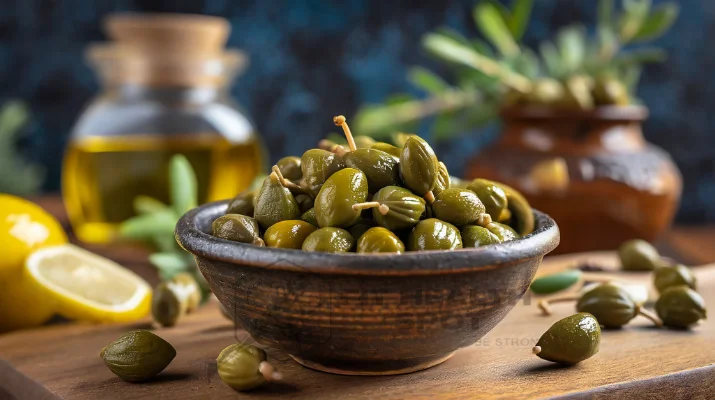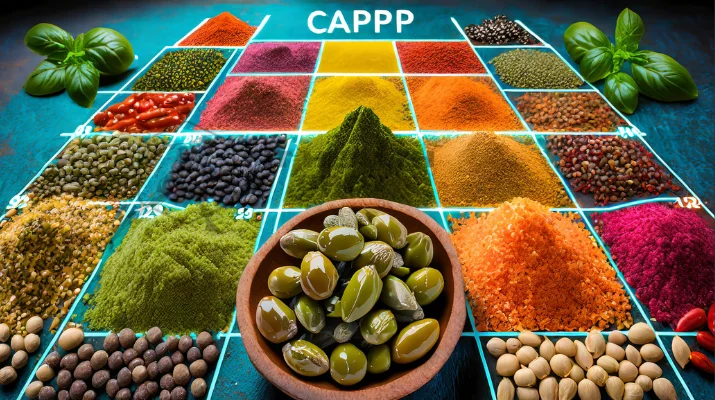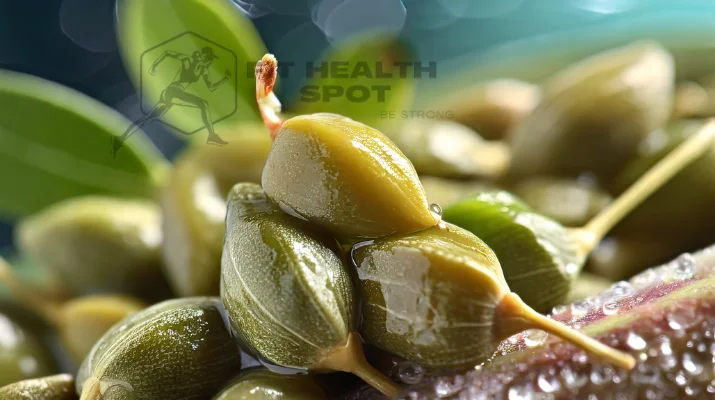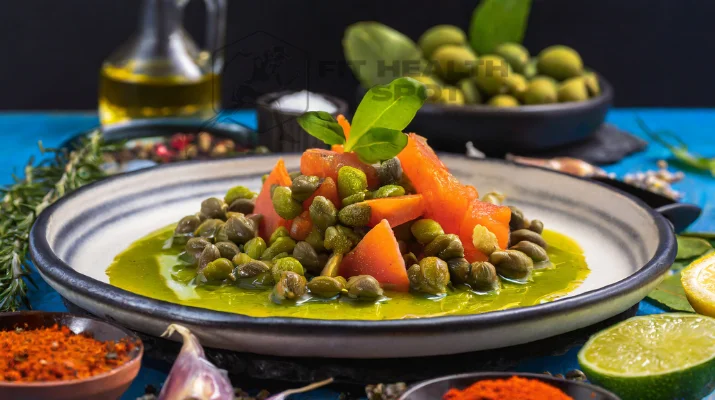Introduction
Capers, those small green pearls that often grace our plates, have a history and culinary reputation that far exceeds their size. As you delve into this article, you’ll discover the origins, uses, and reasons behind the popularity of capers in cuisines around the world.

What exactly are capers? Originating from the caper bush, these edible flower buds are native to the Mediterranean region but have found their way into kitchens worldwide. Their tangy, salty flavor, often intensified by pickling, lends a distinctive touch to various dishes. Whether garnishing a savory dish or adding a zing to sauces, capers are treasured not just for their taste but for the culinary traditions they represent.
Understanding Capers: The Basics
The world of capers extends far beyond the tiny green pearls we see adorning dishes. Their distinct flavor, intriguing appearance, and storied history make them a culinary gem.
What Are Capers?
Capers are the unopened flower buds harvested from the caper bush (Capparis spinosa). These buds, when picked at just the right growth stage and subsequently either pickled in vinegar or salt-cured, metamorphose into the flavorful morsels adored in many cuisines worldwide. Yet, it’s not just their taste that captivates—it’s also their unique background and origins.

A Dive into the Origins, Biology, and History of Capers
The caper bush, predominantly native to the Mediterranean basin, boasts a history that dates back millennia. Ancient manuscripts and age-old recipes hint at capers being an integral culinary component for generations. This enduring legacy has propelled capers from a regional delicacy to a global culinary star.
Discussing the Capers Plant and Where It Grows Best
The caper bush exhibits a penchant for arid landscapes, often sprouting amidst rocky outcrops and along coastal fringes. Its roots are most deep-seated in the Mediterranean, but traces of it can be found across Asia and parts of North Africa. Its resilience, especially in the face of droughts and in nutrient-scarce terrains, is nothing short of commendable—a trait cherished by those aiming to cultivate premium capers.
Comparing Capers with Other Foods
In the realm of nutrition and culinary usage, capers often find themselves juxtaposed with green olives. Both staples of the Mediterranean region they share a common salty, briny profile. While capers are revered for their rich antioxidant content, green olives are celebrated for their heart-healthy fats and abundance of vitamins. As integral components of the Mediterranean diet, they’re both champions in promoting holistic well-being. For those curious about diving deeper into the nutritional world of green olives, there’s an extensive guide on the myriad benefits and varieties of green olives that complement this read.
The Nutritional Profile
When assessing the wide array of foods that grace our kitchens, capers stand out for more than just their distinct taste. Their nutritional profile is impressively robust, making them not only a taste enhancer but also a health-promoting addition to various dishes.
How Capers Fit into Diet and Nutrition
Capers are a low-calorie food, yet they’re rich in essential vitamins, minerals, and antioxidants. They have substantial quantities of vitamin K, a crucial nutrient for both blood clotting and maintaining healthy bones. Moreover, their phytonutrient content, particularly the compounds called rutin and quercetin, has antioxidant properties that can aid in combating harmful free radicals in the body.

Exploring Other Nutrition-Packed Foods
While capers are nutritionally potent, they’re just one of many foods that can enhance one’s diet. For instance, garlic cloves, another kitchen staple, are renowned for their medicinal properties and the ability to boost the immune system. Discover more about the health benefits and uses of garlic cloves here.
Lima beans, often overlooked, are a powerhouse of dietary fiber, protein, and vital minerals. These beans can be a perfect addition to a balanced diet. Delve into the comprehensive guide on the advantages and culinary delights of lima beans here.
Highlighting the Health Benefits of Consuming Capers
Beyond their nutritional content, capers offer specific health benefits. Regular consumption can assist in reducing inflammation, thanks to their antioxidant properties. They’ve also been linked to improved heart health by aiding in the reduction of bad LDL cholesterol.
If you’re passionate about understanding holistic health and the varied ways to achieve it, capers are just a starting point. The realm of health and nutrition is vast and ever-evolving. For those eager to explore more, a deep dive into practices like intermittent and dry fasting can provide insights into alternative health benefits and body rejuvenation. Expand your knowledge of the transformative benefits of intermittent and dry fasting here.
The Sensory Experience
Engaging with capers isn’t just a gastronomic journey; it’s a holistic sensory experience. Their distinct flavor profile, texture, and the sensation they leave on the palate are all elements that have endeared them to culinary enthusiasts worldwide. But how exactly do they taste, and what can they be compared to?
Discussing What Capers Taste Like
At the very first bite, capers present a burst of saltiness, which is primarily due to their brining or curing process. This salinity is quickly followed by a tangy, vinegary note, which is both sharp and refreshing. As these flavors meld on the tongue, there’s an underlying earthiness, a brininess reminiscent of the sea, and a slight bitterness that gives capers their characteristic taste. This combination of flavors makes capers a unique ingredient, bringing depth and complexity to dishes.
Comparison: Capers’ Taste Resonance with Other Foods
It’s challenging to pinpoint an exact parallel for capers in the world of flavors. Some liken their tang to pickles because of the shared brining process. Others might draw a connection to green olives due to their mutual salty and briny characteristics.
Venturing into the broader world of unique tastes, another intriguing flavor profile is that of the green papaya. Unlike the ripe, sweet papaya most are familiar with, green papaya has a crisp texture and a mildly tangy flavor. Used predominantly in Southeast Asian salads and dishes, its taste is an exciting blend of tart and sweet, with a subtle undertone of pepperiness. For those fascinated by the diverse world of flavors, understanding the nuances of green papaya can be an enlightening experience.
The Sensory Experience
Engaging with capers isn’t just a gastronomic journey; it’s a holistic sensory experience. Their distinct flavor profile, texture, and the sensation they leave on the palate are all elements that have endeared them to culinary enthusiasts worldwide. But how exactly do they taste, and what can they be compared to?
Discussing What Capers Taste Like
At the very first bite, capers present a burst of saltiness, which is primarily due to their brining or curing process. This salinity is quickly followed by a tangy, vinegary note, which is both sharp and refreshing. As these flavors meld on the tongue, there’s an underlying earthiness, a brininess reminiscent of the sea, and a slight bitterness that gives capers their characteristic taste. This combination of flavors makes capers a unique ingredient, bringing depth and complexity to dishes.

Comparison: Capers’ Taste Resonance with Other Foods
It’s challenging to pinpoint an exact parallel for capers in the world of flavors. Some liken their tang to pickles because of the shared brining process. Others might draw a connection to green olives due to their mutual salty and briny characteristics.
Venturing into the broader world of unique tastes, another intriguing flavor profile is that of the green papaya. Unlike the ripe, sweet papaya most are familiar with, green papaya has a crisp texture and a mildly tangy flavor. Used predominantly in Southeast Asian salads and dishes, its taste is an exciting blend of tart and sweet, with a subtle undertone of pepperiness. For those fascinated by the diverse world of flavors, understanding the nuances of green papaya can be an enlightening experience.
Capers in Culinary Delights
The world of gastronomy embraces capers with open arms, not just for their distinct taste but also for the unique flair they bring to a variety of dishes. From appetizers to mains, capers have secured a spot in the hearts (and plates) of many culinary enthusiasts. Let’s explore some classic uses and why they remain a favorite.
The Classic Uses of Capers
Capers, known for their zesty kick, possess great flexibility and can enhance the taste of various dishes. Historically, Mediterranean and European cuisines have championed their use. They’re often found sprinkled on pizzas, tossed in salads, and even as a zesty addition to fish dishes.
One of their most beloved roles, however, is as a garnish. The tiny buds, when scattered atop a dish, not only add a burst of flavor but also lend an aesthetic appeal with their contrasting green hue.

Traditional and Popular Dishes: The Magic of Capers in Pasta
Pasta, with its rich history and global appeal, has welcomed capers into its many variants. One classic preparation is the Spaghetti alla Puttanesca, where capers meld with tomatoes, olives, and anchovies to create a robust and flavorful sauce.
Talking about pasta brings us to a specific type that has been gaining popularity – cavatappi pasta. Cavatappi, with its spiral shape, is not just about aesthetics. Its unique design is perfect for holding sauces, ensuring every bite is a delightful mix of pasta and its accompanying flavors. Moreover, when made from whole grains, cavatappi offer a range of health benefits, making it a nutritious choice for pasta lovers.
The Harmonious Pairing of Capers and Lemons
Capers and lemons share a bond in the culinary world, often seen gracing the same dishes, especially in Mediterranean cuisine. But why this pairing? It’s all about balance. The tanginess of capers, combined with the zesty freshness of lemons, creates harmony on the palate. This combination brightens up dishes, cuts through richer flavors, and offers a refreshing contrast, making it a pairing that chefs adore.
Exploring Recipes with Capers
Beyond traditional uses, capers have a versatility that beckons culinary enthusiasts to explore and innovate. Their ability to blend yet stand out in dishes makes them a popular choice for those looking to elevate their cooking. Here, we journey into a few recipes that showcase capers in all their glory.
Healthy Salad with Fried Capers
Fried capers bring an exciting twist to the usual caper experience, offering a crispy texture while retaining their tangy essence.
Ingredients:
- Mixed greens (spinach, arugula, and romaine)
- Cherry tomatoes, halved
- Cucumber, sliced
- Red onion, thinly sliced
- 2 tbsp olive oil
- 2 tbsp capers, drained
- Lemon zest and juice
- Salt and freshly ground pepper, to taste
Instructions:
- Over medium heat, warm up the olive oil in a frying pan.
- Once hot, add the drained capers. Fry until they’re crispy and have opened up, about 3-4 minutes.
- Mix the greens, tomatoes, cucumber, and red onion in a spacious salad bowl.
- Sprinkle the fried capers on top.
- For the dressing, mix lemon zest, juice, salt, and pepper. Drizzle over the salad.
- Toss gently and serve immediately.
Smoked Salmon and Capers on Buckwheat Pancakes
This innovative dish combines the rich flavor of smoked salmon with the tang of capers, all resting on a healthy buckwheat pancake.
Ingredients:
- 1 cup buckwheat flour
- 1 ½ cups milk
- 1 egg
- Smoked salmon slices
- Cream cheese
- Fresh dill
- Capers
- Salt to taste
Instructions:
- In a mixing bowl, combine buckwheat flour, milk, an egg, and a pinch of salt, stirring until the mixture becomes smooth.
- Preheat a non-stick skillet on medium heat. Pour one ladle of batter to create a pancake. Grill until bubbles appear on the surface, then turn it over and cook the opposite side.
- Apply a thin coat of cream cheese onto the pancake.
- Place smoked salmon slices, sprinkle some capers, and garnish with fresh dill.
- Serve immediately.

The Versatility of Oat Bran in Dishes
Another ingredient making waves in the health community is oat bran. Its rich fiber content and heart-friendly properties make it a staple for many. When incorporated into recipes, it adds a pleasant, nutty flavor and a boost of nutrition. Consider adding oat bran to your morning smoothies, muffins or even as a crust for savory pies. Exploring its benefits can also lead to unearthing a myriad of ways to incorporate it into daily meals.
Tips and Tricks for Navigating the World of Capers
Capers, while small in size, are giants in the flavor department. However, to make the most of these green gems, it’s crucial to understand how to store them properly and what to do if you don’t have them on hand. Here, we offer a guide to maximizing the life and flavor of capers, as well as alternatives when you’re in a culinary pinch.
Proper Storage: Keeping Your Capers Fresh
Capers come packed in brine or salt, which acts as a preservative. However, like all perishables, there’s a limit to their freshness.
Do Capers Go Bad?
Yes, capers can go bad if not stored correctly. They can lose their unique taste or even spoil.
How to Store Capers
- Keep Them Sealed: Always ensure that the caper jar’s lid is tightly sealed. This prevents any contamination and maintains freshness.
- Refrigerate After Opening: Once you open a jar of capers, always store it in the refrigerator. This extends their shelf life.
- Submerged in Brine: Make sure that the capers remain submerged in their brine. If the brine level goes down, adding a bit of white vinegar can help maintain their tangy flavor.

Substitutes for Capers
If you find yourself without capers but need their distinctive flavor for a recipe, don’t despair. Here are some alternatives:
- Green Olives: Chopped green olives can capture some of the capers’ briny quality. While they’re more robust, they can be a decent stand-in.
- Pickled Green Peppercorns: These offer a similar tang and bite, making them a close substitute.
- Pickles: Diced pickles can mimic the tartness of capers, though their texture might be a tad different.
Elevate Your Meal with a Drink
Speaking of flavors and pairings, once you’ve created your dish, what better way to complement it than with a refreshing drink? Consider trying green tea shots for a unique beverage experience that not only refreshes the palate but also offers a slew of health benefits.
Conclusion: The Mighty Capers’ Influence on Health and Culinary Arts
Capers, despite their minuscule size, have etched a profound mark on the culinary canvas, imparting an inimitable zest to dishes across cultures. But beyond their culinary charm lies an array of health benefits, making them a double threat in the world of gastronomy.
From a nutritional standpoint, capers pack in a wealth of benefits. Their low-calorie profile, coupled with rich vitamins and antioxidants, make them a valuable addition to any diet, promoting health and wellness. Whether it’s their potential anti-inflammatory properties or the burst of flavor they bring to dishes, there’s no doubting the profound influence of this tiny powerhouse.
Furthermore, in the culinary realm, capers are versatile. They dance seamlessly through various dishes, from kinds of pasta and salads to sauces and meat accompaniments. Their unique taste profile – tangy, salty, with a hint of lemony zest – elevates every dish they grace.
To our avid readers and budding chefs, we implore you: let capers find their way into your kitchen if they haven’t already. Experiment with them, taste them, and let them surprise you. The world of capers is vast and flavorful, waiting for you to dive in and explore its depths.
We appreciate your company on this gastronomic adventure and keep in mind the most exquisite flavors can emerge from the smallest components. Happy cooking!
Engage, Explore, and Expand Your Culinary Horizons
We’ve journeyed through the multifaceted world of capers, but this is just the beginning. As we wrap up, we’d love to hear from you and keep this conversation going.
- Share Your Caper Adventures: Have a unique caper recipe or a memorable experience using them? Drop a comment below and let our community savor your story.
- Stay Updated: If you’ve found value in this exploration, consider subscribing to our newsletter. By doing so, you’ll be the first to know about our latest culinary insights, recipes, and health-focused articles.
- Dive Deeper: Our website is a treasure trove of health and culinary gems. Feel free to explore other related blogs and widen your gastronomic knowledge.
- Further Learning: For those keen on expanding their dietary knowledge, Harvard’s Nutrition Source is an exceptional resource, providing evidence-based information on nutrition and health.
Here’s to continuous learning and flavorful journeys. Until next time, stay curious and eat well!
Frequently Asked Questions about Capers
What Exactly Are Capers?
Capers come from the yet-to-bloom flower buds of the Capparis spinosa plant. They’re commonly used as a seasoning or garnish in various dishes due to their distinct salty and tangy flavor.
How Are Capers Different from Green Olives?
While both capers and green olives have a salty taste, they come from different plants. Capers are flower buds, while olives are fruits. They differ in size, texture, and exact flavor profile, though they often appear together in Mediterranean dishes.
Can I Substitute Capers in a Recipe?
If you don’t have capers on hand, you can use green olives, pickled green peppercorns, or even a small amount of pickled onions as a substitute. However, remember that each of these alternatives will have a slightly different flavor.
What advantages do consuming capers offer for your health?
Capers are packed with antioxidants and have anti-inflammatory properties. They’re also low in calories and contain various vitamins and minerals, including vitamin K, niacin, and riboflavin.
How Do I Store Capers Properly?
Capers are usually sold in brine or salted. Once opened, they should be stored in their original liquid in the refrigerator. Properly stored capers can last for several months.
